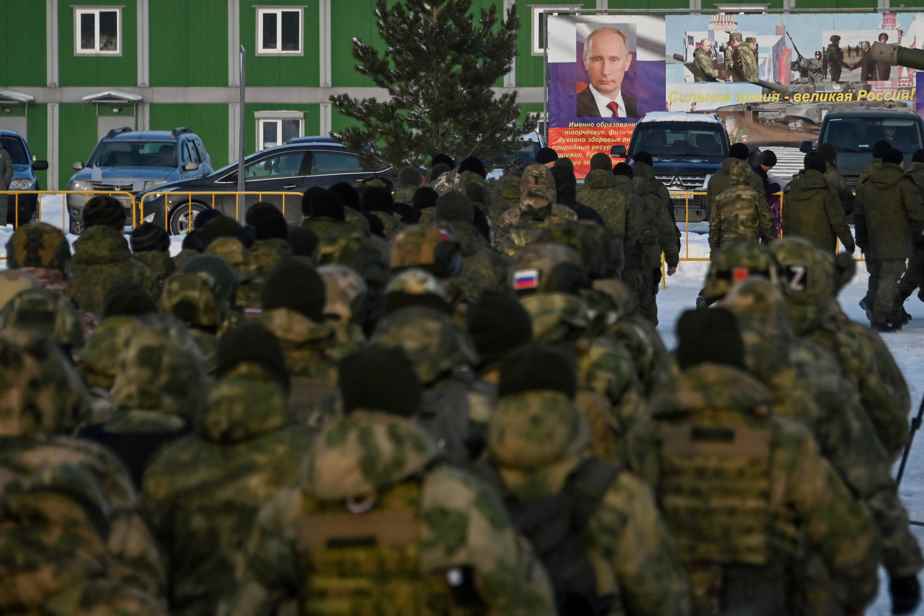(Bakhmout) Artillery duels continued on Friday in Bakhmout, the epicenter of fighting in eastern Ukraine, and shelling elsewhere in the country, despite the entry into force of a unilateral ceasefire decreed by Russia on the occasion of Orthodox Christmas.
AFP journalists heard shots on the Ukrainian and Russian sides after the start of the ceasefire in this city with largely destroyed and deserted streets, but their intensity was lower than in previous days.
Dozens of civilians were gathered in a building used for the distribution of humanitarian aid, where volunteers organized a Christmas celebration, distributing tangerines, apples and cookies, an hour before the entry into force at 4 a.m. (Eastern time) of the Russian truce.
Pavlo Diatchenko, a Bakhmout policeman, said the truce was a Russian “provocation” that would not help civilians in the city. “They are bombed day and night and almost every day there are people killed,” he said.
The Russian army assured to respect its truce, but accused the Ukrainian troops of “continuing to bombard the cities and the Russian positions”.
The deputy head of the Ukrainian presidential administration, Kyrylo Tymoshenko, reported two Russian strikes on Kramatorsk (east) having hit a residential building without causing any casualties. Earlier, before the truce, he had mentioned a Russian bombardment on Kherson (south).
The pro-Russian separatist authorities in eastern Ukraine, for their part, reported several Ukrainian bombardments on their stronghold of Donetsk before and after the theoretical entry into force of the ceasefire, announced the day before by the President Vladimir Putin.
Following a call from the Russian Orthodox Patriarch Kirill, but also a proposal from the Turkish Head of State Recep Tayyip Erdogan, Mr. Putin had asked his army to observe a “ceasefire on the entire line of contact between games beginning at 12:00 p.m. (4:00 a.m. (Eastern time)) on January 6 until midnight (4:00 p.m. (Eastern time)) on January 7”.
Russian ceasefire “not credible”
The head of diplomacy of the European Union (EU) Josep Borrell described as “hypocrisy” the ceasefire announced by Moscow, judging it “not credible”.
“The Kremlin completely lacks credibility and this declaration of a desire for a unilateral ceasefire is not credible,” Josep Borrell told the press on the sidelines of a visit to Fez, Morocco.
“The answer that comes to mind for all of us is skepticism in the face of so much hypocrisy,” he said.
For the ceasefire to be considered valid, “there must be a complete cessation of military attacks. We must have the withdrawal of (Russian) troops and their military equipment from Ukrainian territory,” explained Borrell, after meeting students from the Euro-Mediterranean University.
“In the absence of such concrete actions, a unilateral ceasefire appears as an attempt by Russia to buy time to regroup its troops and try to restore its badly damaged international reputation,” Borrell said. .
He also pointed the finger at Russian “propaganda” which blames “European sanctions” for the global surge in food and energy prices which particularly penalizes Africa.
“It is completely false. It was the Russian army that destroyed the grain silos, that destroyed and sowed mines in the fields, destroyed the roads and blocked the ports of Ukraine,” stressed the senior European official.
This is the first time that a major truce has been announced in Ukraine since the start of the Russian invasion in February 2022. Short halts in fighting had previously been observed locally, such as for the evacuation of civilians from the Azovstal plant in Mariupol (southeast) in April.
Ukraine questioned the sincerity of the Russian initiative, brushing it off as an “act of propaganda”. According to its president Volodymyr Zelensky, it is an “apology with the aim of at least stopping the advance of our troops in the Donbass and bringing equipment, ammunition, and bringing men closer to our positions”.
New American aid
The United States will provide $3 billion in new military aid for Ukraine, the largest package to date, the White House announced Friday.
This assistance, the details of which will be given by the Pentagon later in the day, must also include armored infantry and personnel carriers as well as howitzers, said White House spokeswoman Karine Jean. -Rock.
Washington and Berlin had already announced Thursday that they would deliver armored infantry to Kyiv, of the Bradley type on the American side and of the Marder model on the German side, but had not indicated the models.
In service since the 1970s, the Marder are light armored vehicles intended for troop transport. Their main armament is a 20mm cannon.
The Bradleys are machines more or less of the same family, in service since the beginning of the 1980s. In the model m2they are equipped with a 25 mm cannon as well as an anti-tank missile launcher, and can carry, in addition to the crew, six combatants.
The Bradley “is not a tank, it’s a tank killer,” Pentagon spokesman General Ryder noted Thursday.
“We are convinced that this will help (Ukrainian forces) a lot on the battlefield,” he added.
France was the first to take the plunge by announcing on Wednesday the upcoming delivery of its AMX-10 RC light combat tanks, which the French army has.
Quantities and deadlines have not been specified at this stage.
Berlin has also pledged to provide a Patriot air defense battery, as Washington has already done.
